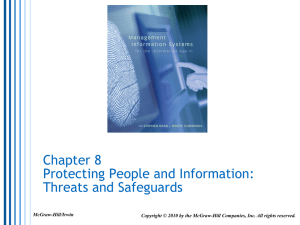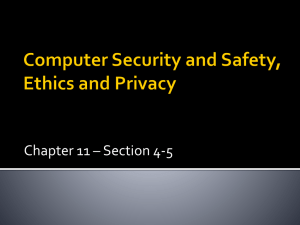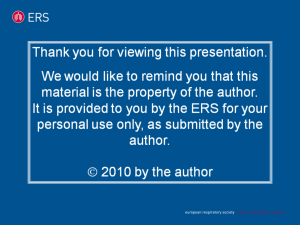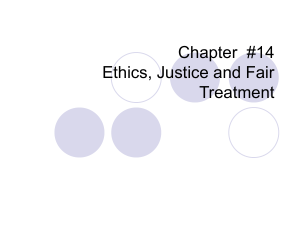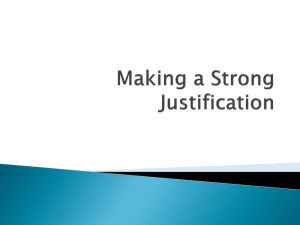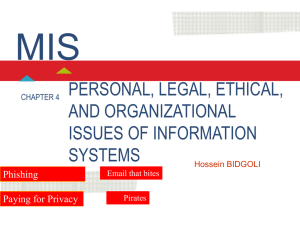strategy implementation
advertisement
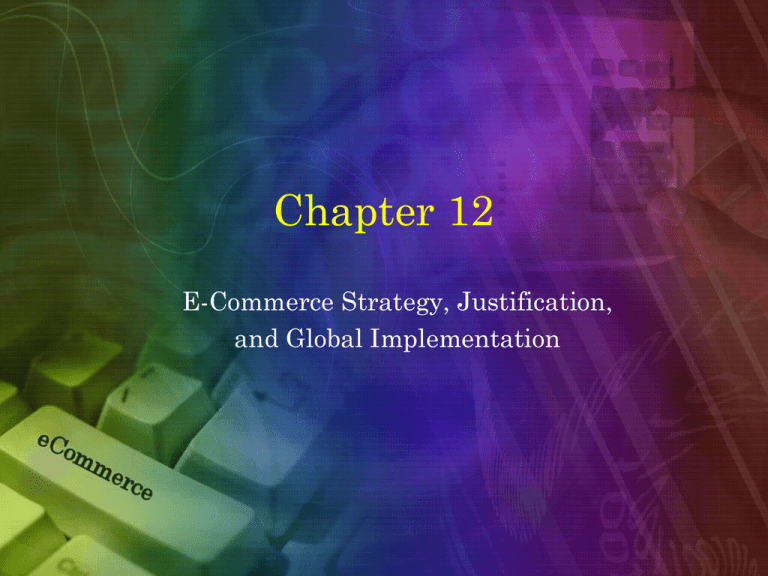
Chapter 12 E-Commerce Strategy, Justification, and Global Implementation Learning Objectives 1. 2. 3. 4. 5. Describe the strategic planning process. Describe the purpose and content of a business plan in e-commerce. Describe EC strategy implementation including the use of metrics. Describe the need for justifying EC investments, how it is done, and how metrics are used to determine justification. Understand the difficulties in measuring and justifying EC investments. Learning Objectives 6. 7. 8. Evaluate the issues involved in global EC. Analyze the impact of EC on SMEs. Understand the foundations for legal and ethical issues in EC. 9. Explain privacy, free speech, and defamation and their challenges. 10. Discuss the challenges caused by spam, splogs, and popups. 11. Describe the anticipated future of EC. Strategy, Planning, and Implementation of ECommerce • strategy A broad-based formula for how a business is going to accomplish its mission, what its goals should be, and what plans and policies will be needed to carry out those goals. Strategy, Planning, and Implementation of ECommerce • STRATEGY AND THE WEB ENVIRONMENT – e-commerce strategy (e-strategy) The formulation and execution of a vision of how a new or existing company intends to do business electronically. Strategy, Planning, and Implementation of ECommerce Strategy, Planning, and Implementation of ECommerce • strategy initiation The initial phase of strategic planning in which the organization examines itself and its environment. Strategy, Planning, and Implementation of ECommerce – Specific outcomes from this phase include: • Company analysis and value proposition – value proposition The benefit that a company’s products or services provide to a company and its customers. • Core competencies • Forecasts • Competitor (industry) analysis Strategy, Planning, and Implementation of ECommerce • strategy formulation The development of strategies to exploit opportunities and manage threats in the business environment in light of corporate strengths and weaknesses. – Specific activities and outcomes from this phase include: • • • • Business opportunities Cost-benefit analysis Risk analysis, assessment, and management Business plan Strategy, Planning, and Implementation of ECommerce • strategy implementation The development of detailed, short-term plans for carrying out the projects agreed on in strategy formulation. – Specific activities and outcomes from this phase include: • Project planning • Resource allocation • Project management Strategy, Planning, and Implementation of ECommerce • strategy assessment The continuous evaluation of progress toward the organization’s strategic goals, resulting in corrective action and, if necessary, strategy reformulation. Strategy, Planning, and Implementation of ECommerce Strategy, Planning, and Implementation of ECommerce • business plan A written document that identifies a company’s goals and outlines how the company intends to achieve the goals and at what cost. • business case A business plan for a new initiative or large, new project inside an existing organization. Strategy, Planning, and Implementation of ECommerce Justification and Cost-Benefit Analysis • Companies need to justify their EC investments as part of strategy formulation – OTHER REASONS WHY EC JUSTIFICATION IS NEEDED – EC INVESTMENT CATEGORIES AND BENEFITS Justification and Cost-Benefit Analysis • HOW IS AN EC INVESTMENT JUSTIFIED? – cost-benefit analysis A comparison of the costs of a project against the benefits. • WHAT NEEDS TO BE JUSTIFIED? WHEN SHOULD JUSTIFICATION TAKE PLACE? Justification and Cost-Benefit Analysis • USING METRICS IN EC JUSTIFICATION – metric A specific, measurable standard against which actual performance is compared. – key performance indicators (KPI) The quantitative expression of critically important metrics. Difficulties in Measuring and Justifying EC Investments and Success Difficulties in Measuring and Justifying EC Investments and Success • DIFFICULTIES IN MEASURING PRODUCTIVITY AND PERFORMANCE GAINS – Data and Analysis Issues – EC Productivity Gains May Be Offset by Losses in Other Areas – Incorrectly Defining What Is Measured – Other Difficulties Difficulties in Measuring and Justifying EC Investments and Success • DETERMINING E-COMMERCE SUCCESS – – – – Product Characteristics Industry Characteristics Seller Characteristics Consumer Characteristics Global E-Commerce • BENEFITS AND EXTENT OF OPERATIONS • BARRIERS TO GLOBAL EC – – – – Cultural Issues Administrative and Legal Issues Geographic Issues and Localization Economic and Financial Issues Global E-Commerce • BREAKING DOWN THE BARRIERS TO GLOBAL EC – – – – – – – Be strategic Know your audience Localize Think globally, act consistently Value the human touch Clarify, document, explain Offer services that reduce barriers E-Commerce in Small and Medium-sized Enterprises • SUPPORTING SMEs – SMEs have a variety of support options. Almost every developed country in the world has a government agency devoted to helping SMEs become more aware of and able to participate in electronic commerce Fundamental Legal, Ethical, and Regulatory Issues • ETHICS, LEGAL, AND REGULATORY CONCEPTS – ethics The branch of philosophy that deals with what is considered to be right and wrong. Fundamental Legal, Ethical, and Regulatory Issues – privacy The right to be left alone and free of unreasonable personal intrusions. – intellectual property Creations of the mind, such as inventions, literary and artistic works, and symbols, names, images, and designs, used in commerce. Fundamental Legal, Ethical, and Regulatory Issues • LAWS ARE SUBJECT TO INTERPRETATION – Free Speech Online Versus Child Protection • Children’s Internet Protection Act (CIPA) U.S. law that mandates the use of filtering technologies in schools and libraries that receive certain types of federal funding. • legal precedent A judicial decision that may be used as a standard in subsequent similar cases. – Political Spam Versus Political Fund-Raising Fundamental Legal, Ethical, and Regulatory Issues • PERSONAL AND PROPERTY RIGHTS – civil litigation An adversarial proceeding in which a party (the plaintiff) sues another party (the defendant) to get compensation for a wrong committed by the defendant. Fundamental Legal, Ethical, and Regulatory Issues Fundamental Legal, Ethical, and Regulatory Issues • INTELLECTUAL PROPERTY LAW (A CIVIL LAW) – copyright An exclusive right of the author or creator of a book, movie, musical composition, or other artistic property to print, copy, sell, license, distribute, transform to another medium, translate, record, perform, or otherwise use. – infringement Use of the work without permission or contracting for payment of a royalty. Fundamental Legal, Ethical, and Regulatory Issues – digital rights management (DRM) An umbrella term for any of several arrangements that allow a vendor of content in electronic form to control the material and restrict its usage. • fair use The legal use of copyrighted material for noncommercial purposes without paying royalties or getting permission. Fundamental Legal, Ethical, and Regulatory Issues – patent A document that grants the holder exclusive rights to an invention for a fixed number of years. – trademark A symbol used by businesses to identify their goods and services; government registration of the trademark confers exclusive legal right to its use. Privacy, Free Speech, and Defamation • opt out Business practice that gives consumers the opportunity to refuse sharing information about themselves. • opt in Agreement that requires computer users to take specific steps to allow the collection of personal information. Privacy, Free Speech, and Defamation • FREE SPEECH – – – – – Web Site Registration Cookies Spyware and Similar Methods RFID’s Threat to Privacy Privacy of Employees • darknet Private online community that is only open to those who belong to it. Privacy, Free Speech, and Defamation • PRIVACY PROTECTION – – – – – Notice or awareness Choice or consent Access or participation Integrity or security Enforcement or redress Privacy, Free Speech, and Defamation • USA PATRIOT Act Uniting and Strengthening America by Providing Appropriate Tools to Intercept and Obstruct Terrorism Act passed in October 2001, in the aftermath of the September 11 terrorist attacks. Its intent is to give law enforcement agencies broader range in their efforts to protect the public. Spam, Splogs, and Pop-Ups • search engine marketing (SEM) Marketing methods used to increase the ranking of a Web site in the search results. • comment spam Spam sent to all types of messaging media, including blogs, IM, and cellular telephones to promote products or services. Spam, Splogs, and Pop-Ups • search engine spam Pages created deliberately to trick the search engine into offering inappropriate, redundant, or poor-quality search results. • search engine spamming Collective term referring to deceptive online advertising practices. Spam, Splogs, and Pop-Ups • spam site Page that uses techniques that deliberately subvert a search engine’s algorithms to artificially inflate the page’s rankings. • splogs Short for (spam blog) are sites that are created solely for marketing purposes. • trackback An acknowledgment or signal from an originating site to a receiving site. Spam, Splogs, and Pop-Ups – Automated Spam • Captcha tool Short for “completely automated public Turing test to tell computers and humans apart,” this tool uses a verification test on comment pages to stop scripts from posting automatically. • PROTECTING AGAINST POP-UP ADS – Tools for Stopping Pop-Ups Spam, Splogs, and Pop-Ups The Future of Electronic Commerce • INTEGRATING THE MARKETPLACE WITH THE MARKETSPACE • MOBILE SOCIAL NETWORKS • FUTURE THREATS – – – – Security concern Lack of Net neutrality Copyright complaints Choppy connectivity Managerial Issues 1. 2. 3. 4. 5. 6. 7. 8. What is the strategic value of EC to the organization? Who determines EC strategy? What are the benefits and risks of EC? What metrics should we use? How do we measure the value of EC investment? How can we go global? Can we learn to love smallness? What legal and ethical issues should be of major concern to an EC enterprise? 9. What are the most critical ethical issues? Summary 1. The strategic planning process. 2. Writing a business plan. 3. The EC strategic process. 4. The need for EC justification. 5. The difficulties in justifying EC investment. 6. Issues in global EC. 7. Small businesses and EC. 8. Understanding the foundation for legal and ethical issues. 9. Privacy, free speech, and defamation and their challenges. 10. Challenges caused by spam, splogs, and pop-ups. 11. The future of EC.
